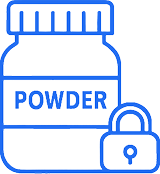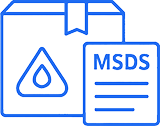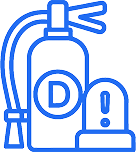Powder Safety
Management
Metal powders exist in fine particle form and pose risks such as fire, explosion, and health hazards, making strict safety management essential.
-

- 1Safe and Clean Storage
- Store in sealed containers and protect from direct sunlight and moisture
- Maintain a low-vibration, low-impact environment to prevent dust dispersal
- Install local exhaust systems and HEPA filters to minimize powder dispersion
-

- 2Prevention of Static Electricity and Fire Hazards
- Powders may ignite upon contact with static electricity—use anti-static equipment and proper grounding
- Use explosion-proof certified equipment and keep away from open flames and heat sources
- Powders such as Mg, Al, Ti, and Zr are classified as pyrophoric or explosive—handle with extra caution
-

- 3Fire Suppression Systems and Response Procedures
- Do not use water extinguishers on metal powder fires → Use Class D extinguishers (e.g., dry powder agents)
- Metal powders that react with moisture pose explosion risks—dry suppression methods are essential
-

- 4Hazardous Materials and Health Management
- Wear masks (N95 or higher), dust-proof suits, and protective goggles to prevent inhalation
- Regularly measure airborne dust concentration indoors
- Use protective gear for skin, as direct contact may cause irritation
-

- 5Labeling and MSDS (Material Safety Data Sheet) Management
- Label each container with powder name, hazard warnings, batch number, and expiration date
- Maintain MSDS documentation for each powder to ensure emergency preparedness
-

- 6Transport Precautions
- Metal powders may be classified as UN hazardous materials—comply with labeling and packaging regulations
- Use double packaging and shock-absorbing materials to prevent damage or leakage
-

- 7Waste and Recovery Management
- Unused powders should be recycled or disposed of following proper procedures
- Do not reuse oxidized or contaminated powders
-

- 8Record Keeping and Training
- Operate a tracking system for incoming, outgoing, usage, and disposal records
- Conduct regular safety training and fire drills for employees
